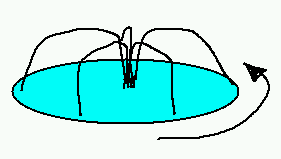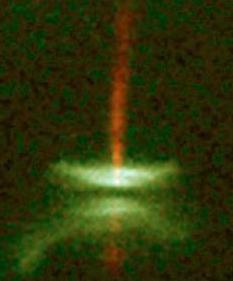-
What really happens in nature during the collapse of the molecular cloud is a
bit more complicated than outlined previously. The most important issue to be
discussed is that of Angular Momentum.
| Angular Momentum. You know it in day-to-day experiences: It's difficult to walk to the center of a merry-go-round ONLY when its spinning. All material from the molecular cloud can't just drop to the center because most of it will have at least some component of rotation relative to the center of the cloud. As it moves in, the rotation speeds up, inhibiting further infall. |

|
|
Instead of falling directly onto the protostar, most of the material from
the molecular cloud builds up in an extended
disk, first. The material in the disk heats up due to collisions,
and thereby converts its ANGULAR MOMENTUM to thermal energy. This
allows the material in the disk to move further and further in.
We see these disks (shown in green light) around very young stars called T Tauri stars. These T Tauri stars also show bipolar flows and jets (perpendicular to the disks, seen here in red light). |

|
